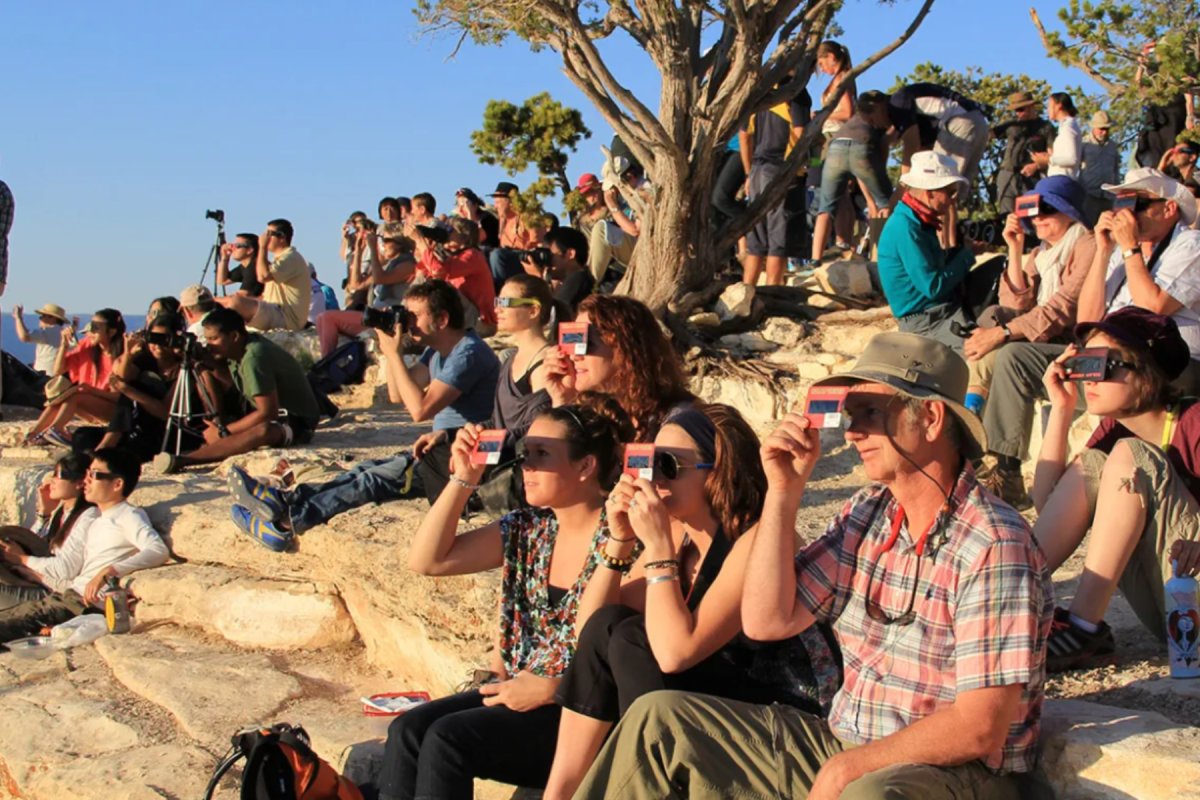On April 8, several U.S. states will be plunged into total darkness as a solar eclipse makes its way across the country.
Around 31.6 million people across over 12 states—Texas, Oklahoma, Arkansas, Missouri, Illinois, Indiana, Ohio, New York, Pennsylvania, Vermont, New Hampshire and Maine—will be in the path of the totality, with millions more able to view a partial eclipse. This will mark the last total solar eclipse visible from the contiguous U.S. until 2044.
Those gathering to watch this cosmological treat are warned not to stare directly into the sun, however, and use protective measures to avoid eye damage during the moments before and after the sun being totally engulfed by the shadow of the moon.
ISTOCK / GETTY IMAGES PLUS / NASA/Mamta Patel Nagaraja
Is it safe to look at a solar eclipse?
It’s dangerous to look directly at the sun during an eclipse as the intense light and radiation emitted by our sun can cause severe and permanent damage to the eyes. Ultraviolet radiation can cause sunburn of the cornea, known as solar keratitis, and can also lead to solar retinopathy, which is when a hole is burned into the retina (the light-sensitive layer at the back of the eye).
This can occur after observing the sun with the naked eye, or via a camera lens, binoculars, or telescope without a special-purpose solar filter. To protect your eyes during an eclipse, it’s crucial to use proper eye protection such as solar viewing glasses or indirect viewing methods like pinhole projectors. These methods allow you to safely observe the eclipse without risking eye damage.
How to protect your eyes during a solar eclipse
One way to protect your eyes is by using solar viewing glasses specifically designed for viewing eclipses or solar events. These glasses have special filters that block out harmful ultraviolet, visible, and infrared radiation.
“Eclipse glasses are NOT regular sunglasses; regular sunglasses, no matter how dark, are not safe for viewing the Sun. Safe solar viewers are thousands of times darker and ought to comply with the ISO 12312-2 international standard,” NASA advised in a post about eclipse safety.
Where can I get eclipse glasses?
American Paper Optics, the largest supplier of eclipse glasses in the U.S., sells the glasses online, as does Amazon and other retailers. Several eclipse websites like GreatAmericanEclipse.com and NationalEclipse.com also sell a range of eclipse gadgets, including eyewear.
How to make a pinhole camera
You can create a simple pinhole projector to indirectly view the eclipse. Instead of staring up at the sun, you’ll see the eclipse projected onto a screen surface.
An easy pinhole camera can be made using two pieces of stiff cardboard, some aluminum foil, tape, scissors, and a pin or needle.
First, take one piece of cardboard and cut out a small square or rectangle from the center. This will be the frame of your pinhole projector. Cover the hole with aluminum foil and tape it securely onto the cardboard. Use a pin or needle to poke a small hole in the center of the aluminum foil. This will be your pinhole. Take the second piece of cardboard and place it on the ground or another flat surface. This will act as your screen.
Position the cardboard with the pinhole between the sun and the cardboard screen. Hold it so that the sunlight passes through the pinhole and projects an image onto the screen. Adjust the distance between the pinhole projector and the screen until you see a clear and focused image of the sun. The image will appear inverted but well-defined.
Alternatively, a box can be used to generate a similar image.
“Do NOT look at the Sun through the pinhole!” NASA warns.
Use solar filters for telescopes and binoculars
If you’re using binoculars or a telescope to observe the eclipse, ensure that they have proper solar filters. Never look at the sun through an unfiltered telescope or binoculars, as this can cause serious eye damage.
“Do NOT use eclipse glasses or handheld viewers with cameras, binoculars, or telescopes. Those require different types of solar filters. When viewing the partial phases of the eclipse through cameras, binoculars, or telescopes equipped with proper solar filters, you do not need to wear eclipse glasses,” NASA said.

National Park Service
Live streams
If you’re unable to view the eclipse in person or if it’s not visible from your location, many organizations and websites will offer live streams of the event. This allows you to experience the eclipse safely from the comfort of your own home.
Finally, if you are watching an eclipse for an extended period of time, you may expose your skin to direct sunlight for a while, so be sure to wear SPF to prevent skin damage.
Do you have a tip on a science story that Newsweek should be covering? Do you have a question about solar eclipses? Let us know via [email protected].
Uncommon Knowledge
Newsweek is committed to challenging conventional wisdom and finding connections in the search for common ground.
Newsweek is committed to challenging conventional wisdom and finding connections in the search for common ground.


